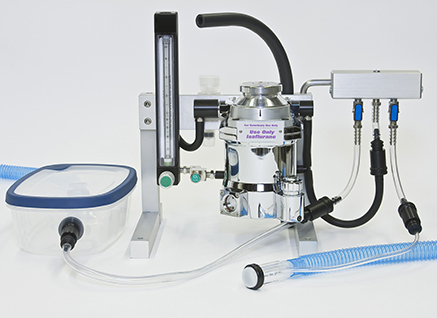By Sherrie Jean, DVM, DACLAM
Associate Veterinarian
Yerkes National Primate Research Center

© Parkland Scientific, Inc.
Many biomedical and basic science research studies involve the use of rodent animal models. The animals and experimental agents (eg. cell lines, chemicals, biologicals, etc.) involved with these projects often pose a human health and safety risk to the personnel conducting those studies. Human hazards exist from the use of hazardous agents as well as from the handling and manipulation of the animals. In conducting experimental studies using animal models it is common to administer either biological (eg. cell lines, infectious agents) or chemical (eg. carcinogens, mutagens, caustic agents, etc.) hazardous agents to the animals. Experimental agent administration in rodents frequently involves the use of needles for subcutaneous (SQ), intraperitoneal (IP), or intravenous (IV) injection. The consequences of auto-injection and inoculation can be life-threatening to humans/rodents depending upon the agent and site of injury. There are several options that can be incorporated to mitigate and/or eliminate the anticipated and unanticipated risks associated with the use of sharps (needles) on rodents.
The first option is to eliminate the risk all together if possible. This would involve a different method of administration that doesn’t involve sharps (eg. oral). The next option is to engineer out the risk. This can involve many options such as using anesthesia or a restraint device to restrain the animal. More information can be found through Emory University/Division of Animal Resources (DAR), and standard operating procedures from the Institutional Animal Care and Use Committee (IACUC) of Emory University.
Anesthesia or sedation will eliminate the risks associated with sudden movements or the animal struggling. This can be particularly helpful in circumstances where the animals are not handled often and thus are not relaxed during restraint or if the user is less experienced with hand restraint and has difficulty sufficiently immobilizing the animals during injection. The National Institute of Occupational Safety and Health (NIOSH) have established a Recommended Exposure Limit (REL) of 2 ppm as a ceiling limit over a 1-hour time period for all halogenated anesthetic agents. Gas anesthesia (isoflurane) is extremely useful in this situation because it takes approximately 10-20 seconds for the animals to become anesthetized once exposed to the gas (induction). This is typically done in an anesthesia chamber/container, which minimizes risk to humans. If you have access to an anesthesia machine that has a nose cone the animals can be transferred to the nose cone and remain on gas anesthesia throughout the procedure. If you don’t have access to an anesthesia machine, once the animal is removed from the chamber and exposed to room air it will be immobile for about 10-20 seconds (enough time for an injection). When they start waking up and moving it is approximately another 10 seconds until they are fully awake and walking around the cage (i.e. recovered). DAR at the School of Medicine has anesthesia machines available to use for no charge when scheduled in advance. EHSO is currently working on requirements and standard operating procedures and safety for isoflorane. To get more information on gas anesthesia and anesthesia machine usage please contact:
- Emory University School of Medicine: DAR training coordinators (dartrn@emory.edu)
- Yerkes NPRC: Dr. Denyse Levesque (dlevesq@emory.edu) or Dr. Sherrie Jean (smjean@emory.edu)
If anesthesia is not an option, restraint devices are available so that injections can be given without the need for manual restraint. These devices come in a variety of shapes and sizes depending upon the animal and the type of injection. DAR veterinarians can help you with picking out a device to best suit your need. Another engineering modification is the use of needle-safe systems. Needle-safe systems consists of needles that re-sheath the needle automatically or that retract once used. Another engineering modification is the use of a needle-locking/leur lock type of syringe or a disposable unit where the needle is an integral part of the syringe which prevents separation of the needle and syringe during injection.
Once you have exhausted the possibilities for engineering out the risks, the next safety precaution is developing work policies and procedures (SOPs) that foster good work practices. There are a number of safety precautions that are standard at Emory University when working with sharps, for example:
- Do not walk around with an uncapped needle.
- Avoid hand-to-hand passage of sharps.
- Dispose of sharps in appropriate containers. Ensure convenient access to sharps containers in all areas where needles might be used.
- Do not recap needles. If recapping cannot be avoided, use a one-hand scoop method or hold the cap with a mechanical device such as forceps.
- Bending, breaking, or clipping needles is strongly discouraged.
- Never try to remove anything from a sharps container.
- Do not fill sharps containers beyond the designated fill limit.
The last option is to protect yourself with PPE. Any time there is a risk for aerosol or droplet formation those procedures should be performed in a biosafety cabinet (BSC). Examples of when aerosols or droplets can be generated are when a needle disengages from a syringe in the process of injection, forcing material through small bore needles, overfilling of a vacutainer tube. PPE to protect mucous membranes (eyes, nose, mouth) should be worn anytime there is a potential to cause aerosolization or sprays.
Please contact EHSO or DAR Veterinarians for more information and to explore your options for refining and improving your policies and procedures involving the use of sharps when working with animals.
